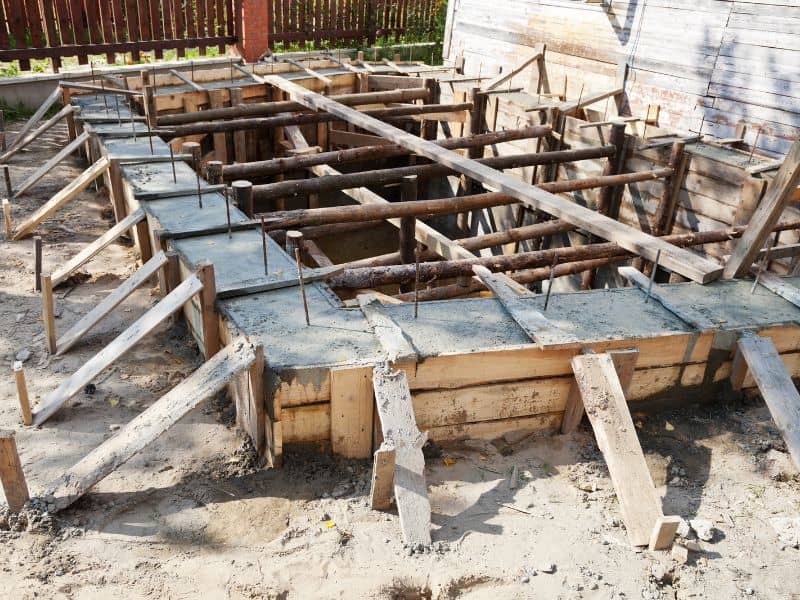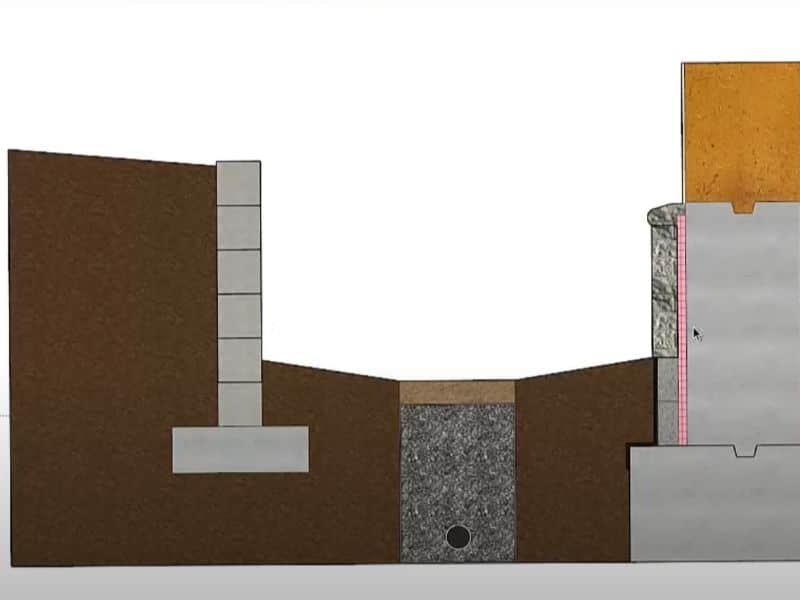Cob House Foundations: 6 Steps to Build a Solid Base for a Home

You need a strong cob house foundation — if your foundation crumbles, your entire cob house will crumble too.
Besides providing structural support, the foundation helps distribute the building’s weight evenly, making it safe and suitable for occupation. Cob house foundations require careful planning and execution to ensure a sturdy, lasting structure.
Although cob is one of the common sustainable building materials, these buildings are highly susceptible to water damage. Therefore, houses made with cob require a robust foundation that’s thick enough to hold up against the elements while protecting your home from water damage.
In this article, I’ll discuss how to build cob house foundations and their main components. I’ll also discuss the different materials to use. Let’s get right in!
Components of Cob House Foundations

Before diving into how to build a cob house foundation, it’s important to understand its various components.
The following are the main components of cob house foundations:
Footers
These form the deepest part of any foundation.
Footers are essential for distributing the weight from the walls and the rest of the house. They are wider than stem walls to prevent the foundation from settling.
The main types of foundation footers include:
- Individual footings: These are the most common types used for small structures like sheds and porches. They also come in handy in places with high water tables or soft soils.
- Combined footings: These are ideal where two or more foundation walls converge. The idea is to distribute the load and prevent settling. They’re also installed in cases where one foundation wall is taller than the other.
- Strip footings: They have an excellent load-bearing capacity that makes them ideal for supporting linear loads in different types of subsoils.
- Raft/mat foundation: These are ideal for large structures. The idea is to spread the load from one foundation wall across several footings, making it ideal where soil conditions vary.
Stem walls

This section sits on the underground footer and extends above ground.
Stem walls provide structural support by transmitting the building’s load to the footing.
These walls are especially important for cob houses because they act as a moisture breaker between the walls and the ground.
For efficiency, stem walls for earthen buildings like cob should extend 1.5 to 2 feet (0.46 to 0.61 meters) above the ground level. This way, you can rest assured your foundation is protected from water damage.
Reinforcement
Rebar (steel reinforcement) is necessary for all foundations.
Rebar helps strengthen the foundation, especially when dealing with high-traffic areas or heavy loads. It holds concrete components like stem walls and footers in tension.
It’s important to use galvanized steel for added durability and protection against corrosion.
Drainage
Cob house foundations must have a drainage system along their outside perimeters. The drainage system drains water from the foundation, preventing it from eroding or cracking.
This ensures that any water is directed away from the foundation, preventing wall erosion or cracking.
Expert advice: Your foundation should be beneath the frost line to prevent frost heave, which can cause structural damage to the foundation. The deeper the foundation, the more secure and stable it will be.
Materials for Cob House Foundations

The materials to use in a cob house foundation depend on the soil conditions, climate, the size of the building, and local codes.
The most common cob house foundation materials include:
- Concrete: It’s the best foundation material because, besides being strong and durable, it doesn’t burn or rot.
- Stone: Natural stone is the most durable foundation material. However, stone foundations are labor-intensive and require specialized installation knowledge. It can be challenging to get a mason experienced in laying stone foundations.
- Blocks and brick: They are ideal for building stem walls and can be used with concrete footers. Although they’re easily stackable, bricks and blocks are non-monolithic. Therefore, they require additional sizing to match the size of the cob walls.
How to Build Cob House Foundations
Now that you know the components of a cob house foundation and the best materials, let’s get into the nitty-gritty of building one.
Step 1: Mark Out the Foundation
Use a wooden stake and a string to outline the foundation. Make sure it’s level and adjust accordingly.
Step 2: Prepare the Soil and Excavate the Foundation
Ensure you have a stable base before commencing construction.
Remove any unstable soil or vegetation from the area before excavating the foundation along the edges of the marked-out area.
A rule of thumb is to excavate up to 1+ meters deep (3.28+ feet), 1 meter (3.28 feet) wide at the top, and 0.7 meters (2.30 feet) at the bottom.
Step 3: Level the Ground

Ensure the excavated ground is hard earth. If not, pour a 30 cm (11.81 inches) layer of sand or small stones and fully compact it until the ground is level.
The ground should also be well-drained, ideally with a slight slope so water doesn’t accumulate.
Step 4: Build the Footer
Set your footings 2 feet (0.61 m) across. Add 2 feet (0.61 m) on either side of the formwork for sufficient space to lay the foundation.
Once that’s done, build the forms for the footing by aligning 2-inch (50.8 mm) wide by 10-inch (254 mm) long boards in the planned foundation shape.
Finally, mix concrete to lay down a solid footer at least 6 inches (152 mm) thick along your foundation’s perimeter. Pour the concrete into the formwork, ensuring it’s level.
Use a vibrator to expel air from the concrete and drill a little groove (2×4 inch) at the top for integrating with the stem wall later.
Leave the footer to cure for 28 days.
Step 5: Build a Rubble Trench
It’s advisable to build a rubble trench for proper drainage.
The rubble trench goes beneath the stem walls and is filled with drain rock (round gravel or small stones).
Cover the bottom of the trench with a few inches of drain rock. Once that’s done, lay a 4 inch (1012 mm) perforated polyethylene drain pipe along the bottom to improve drainage runoff.
Step 6: Build the Stem Wall
Once your footer and rubble trenches are ready, you can start building your stem wall with blocks/brick, or concrete.
If you go with concrete, you’ll need a forming system for support. A 2 by 8 inch (50.8 by 203.2 mm) form material should be adequate.
Once the forms are up, mix and pour the concrete. Trowel it smoothly and use a vibrator to expel air before creating a little groove (2×4 inch) at the top for easy integration with your cob walls.
Finally, let the stem wall cure for at least 28 days before building your cob house walls on top of the foundation.
The video below is an overview of the above steps:

Final Thoughts
When building cob house foundations, you want to ensure that runoff water is diverted away from your foundation and not towards it.
Moreover, the deeper you excavate, the stronger the foundation.
Finally, remember that a cob house foundation must be well-drained for to protect your walls.
Now that you know about cob house foundations, here is our guide to using a reclaimed wood mantel for your fireplace to give you further inspiration for making the most of sustainable materials.







